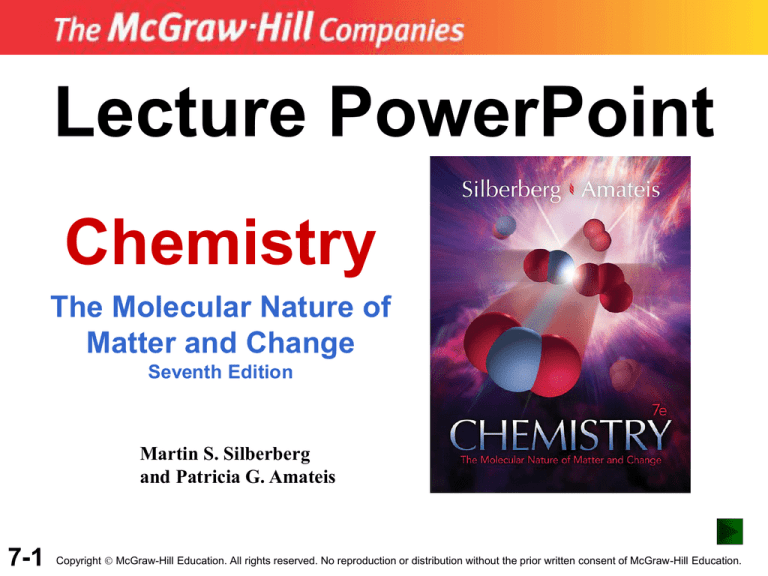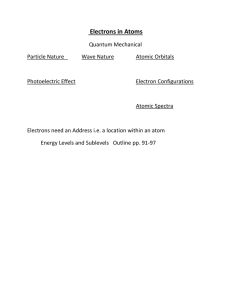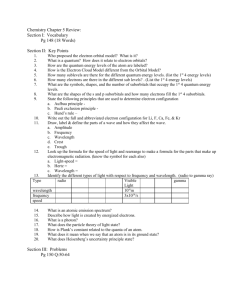
Lecture PowerPoint
Chemistry
The Molecular Nature of
Matter and Change
Seventh Edition
Martin S. Silberberg
and Patricia G. Amateis
7-1
Copyright McGraw-Hill Education. All rights reserved. No reproduction or distribution without the prior written consent of McGraw-Hill Education.
Chapter 7
Quantum Theory and Atomic Structure
7-2
Quantum Theory and Atomic Structure
7.1 The Nature of Light
7.2 Atomic Spectra
7.3 The Wave-Particle Duality of Matter and Energy
7.4 The Quantum-Mechanical Model of the Atom
7-3
The Wave Nature of Light
Visible light is a type of electromagnetic radiation.
The wave properties of electromagnetic radiation are
described by three variables:
- frequency (n), cycles per second
- wavelength (l), the distance a wave travels in one cycle
- amplitude, the height of a wave crest or depth of a trough.
The speed of light is a constant:
c=nxl
= 3.00 x 108 m/s in a vacuum
7-4
Figure 7.1 The reciprocal relationship of frequency and wavelength.
7-5
Figure 7.2
7-6
Differing amplitude (brightness, or intensity) of a wave.
Figure 7.3
7-7
Regions of the electromagnetic spectrum.
Sample Problem 7.1
Interconverting Wavelength and Frequency
PROBLEM: A dental hygienist uses x-rays (l= 1.00Å) to take a series
of dental radiographs while the patient listens to a radio
station (l = 325 cm) and looks out the window at the blue
sky (l= 473 nm). What is the frequency (in s-1) of the
electromagnetic radiation from each source? (Assume that
the radiation travels at the speed of light, 3.00x108 m/s.)
PLAN:
Use the equation c = nl to convert wavelength to frequency.
Wavelengths need to be in meters because c has units of m/s.
wavelength in units given
use conversion factors
1 Å = 10-10 m
wavelength in m
n= c
l
frequency (s-1 or Hz)
7-8
Sample Problem 7.1
SOLUTION:
For the x-rays:
-10
l = 1.00 Å x 10 m = 1.00 x 10-10 m
1Å
3.00 x 108 m/s
c
=
n=
l
1.00 x 10-10 m
For the radio signal:
For the blue sky:
7-9
n= c =
l
n= c =
l
3.00 x 108 m/s
10-2 m
325 cm x
1 cm
3.00 x 108 m/s
10-9 m
473 nm x
1 nm
= 3.00 x 1018 s-1
= 9.23 x 107 s-1
= 6.34 x 1014 s-1
Figure 7.4
7-10
Different behaviors of waves and particles.
Figure 7.5
7-11
Formation of a diffraction pattern.
Energy and Frequency
A solid object emits visible light when it is heated to about
1000 K. This is called blackbody radiation.
The color (and the intensity ) of the light changes as the
temperature changes. Color is related to wavelength and
frequency, while temperature is related to energy.
Energy is therefore related to frequency and wavelength:
E = nhn
7-12
E = energy
n is a positive integer
h is Planck’s constant
Figure 7.6
Familiar examples of light emission related to
blackbody radiation.
Smoldering coal
7-13
Electric heating element
Lightbulb filament
The Quantum Theory of Energy
Any object (including atoms) can emit or absorb only
certain quantities of energy.
Energy is quantized; it occurs in fixed quantities, rather
than being continuous. Each fixed quantity of energy is
called a quantum.
An atom changes its energy state by emitting or
absorbing one or more quanta of energy.
DE = Dnhn where n can only be a whole number.
7-14
Figure 7.7
7-15
The photoelectric effect.
Sample Problem 7.2
Interconverting Energy, Wavelength and
Frequency
PROBLEM: A student uses a microwave oven to heat a meal. The
wavelength of the radiation is 1.20 cm. What is the energy
of one photon of this microwave radiation?
We know l in cm, so we convert to m and find the frequency
using the speed of light. We then find the energy of one
photon using E = hn.
PLAN:
SOLUTION:
E = hn =
7-16
hc
l
=
(6.626 x 10-34 J∙s)(3.00 x 108 m/s)
10-2 m
(1.20 cm)(
)
1 cm
= 1.66 x 10-23 J
Figure 7.8
7-17
The line spectrum of hydrogen.
Figure 7.9 Three series of spectral lines of atomic hydrogen.
Rydberg equation
1
l
=
R
1
–
2
n1
1
n22
R is the Rydberg constant = 1.096776x107 m-1
for the visible series, n1 = 2 and n2 = 3, 4, 5, ...
7-18
The Bohr Model of the Hydrogen Atom
Bohr’s atomic model postulated the following:
• The H atom has only certain energy levels, which Bohr
called stationary states.
– Each state is associated with a fixed circular orbit of
the electron around the nucleus.
– The higher the energy level, the farther the orbit is
from the nucleus.
– When the H electron is in the first orbit, the atom is in
its lowest energy state, called the ground state.
7-19
• The atom does not radiate energy while in one of its
stationary states.
• The atom changes to another stationary state only by
absorbing or emitting a photon.
– The energy of the photon (hn) equals the difference
between the energies of the two energy states.
– When the electron is in any orbit higher than n = 1,
the atom is in an excited state.
7-20
Figure 7.10
7-21
A quantum “staircase” as an analogy for atomic
energy levels.
Figure 7.11
7-22
The Bohr explanation of three series of spectral lines
emitted by the H atom.
A tabletop analogy for defining the energy of a system.
DE = Efinal – Einitial =
7-23
–2.18x10-18
J
1
–
n2final
1
n2initial
Sample Problem 7.3
Determining DE and l of an Electron
Transition
PROBLEM: A hydrogen atom absorbs a photon of UV light (see Figure
7.11) and its electron enters the n = 4 energy level.
Calculate (a) the change in energy of the atom and
(b) the wavelength (in nm) of the photon.
PLAN: (a) The H atom absorbs energy, so Efinal > Einitial. We are given
nfinal = 4, and Figure 7.11 shows that ninitial = 1 because a UV
photon is absorbed. We apply Equation 7.4 to find DE.
(b) Once we know DE, we find frequency and wavelength.
7-24
Sample Problem 7.3
SOLUTION:
(a) DE =
–2.18x10-18
=
–2.18x10-18
J
1
1
–
= -2.18x10-18 J
2
2
n final n initial
J
1
1
–
16
1
= 2.04 x 10-18 J
-34
8
(b) l = hc = (6.626x10 J∙s)(3.00x10 m/s)
DE
2.04x10-18 J
9.74x10-8 m x 1 nm
10-9 m
7-25
1
1
–
42
12
= 97.4 nm
= 9.74 x 10-8 m
Tools of the Laboratory
Figure B7.1
Flame tests and fireworks.
strontium 38Sr
copper 29Cu
The flame color is due to the emission
of light of a particular wavelength by
each element.
7-26
Fireworks display emissions similar to
those seen in flame tests.
Tools of the Laboratory
Figure B7.2
7-27
Emission and absorption spectra of sodium atoms.
Tools of the Laboratory
Figure B7.3
7-28
Components of a typical spectrometer.
Tools of the Laboratory
Figure B7.4 Measuring chlorophyll a concentration in leaf extract.
7-29
The Wave-Particle Duality of Matter and Energy
Matter and Energy are alternate forms of the same entity.
E = mc2
All matter exhibits properties of both particles and
waves. Electrons have wave-like motion and therefore
have only certain allowable frequencies and energies.
Matter behaves as though it moves in a wave, and the
de Broglie wavelength for any particle is given by:
h
l=
mu
7-30
m = mass
u = speed in m/s
Figure 7.12
7-31
Wave motion in restricted systems.
Table 7.1
Mass (g)
Slow electron
9x10-28
1.0
7x10–4
Fast electron
9x10-28
5.9x106
1x10–10
Alpha particle
6.6x10-24
1.5x107
7x10–15
1-gram mass
1.0
0.01
7x10–29
142
40.0
1x10–34
3.0x104
4x10–63
Earth
6.0x1027
Speed (m/s)
l (m)
Substance
Baseball
7-32
The de Broglie Wavelengths of Several Objects
Sample Problem 7.4
PROBLEM:
PLAN:
Calculating the de Broglie Wavelength of an
Electron
Find the deBroglie wavelength of an electron with a speed
of 1.00x106 m/s (electron mass = 9.11x10-31 kg;
h = 6.626x10-34 kgm2/s).
We know the speed and mass of the electron, so we substitute
these into Equation 7.5 to find l.
SOLUTION:
l=
h
mu
6.626x10-34 kg∙m2/s
l=
9.11x10-31 kg x 1.00x106 m/s
7-33
= 7.27 x 10-10 m
Figure 7.13
Diffraction patterns of aluminum with x-rays and
electrons.
x-ray diffraction of aluminum foil
7-34
electron diffraction of aluminum foil
Figure 7.14 False-color scanning electron micrograph of blood cells.
7-35
Figure 7.15
CLASSICAL THEORY
Matter
particulate,
massive
Energy
continuous,
wavelike
Major observations and theories
leading from classical theory to
quantum theory
Since matter is discontinuous and particulate,
perhaps energy is discontinuous and particulate.
Observation
Blackbody radiation
7-36
Theory
Planck:
Photoelectric effect
Energy is quantized; only certain values
allowed.
Einstein: Light has particulate behavior (photons).
Atomic line spectra
Bohr:
Energy of atoms is quantized; photon
emitted when electron changes orbit.
Figure 7.15 continued
Since energy is wavelike,
perhaps matter is wavelike.
Observation
Davisson/Germer:
Electron beam is
diffracted by metal
crystal.
Theory
deBroglie: All matter travels in waves; energy of
atom is quantized due to wave motion of
electrons.
Since matter has mass,
perhaps energy has mass.
Observation
Theory
Compton:
Einstein/deBroglie: Mass and energy are
equivalent; particles have
Photon’s wavelength
increases (momentum
wavelength and photons have
decreases) after colliding
momentum.
with electron.
QUANTUM THEORY
7-37
Energy and Matter
particulate, massive, wavelike
Heisenberg’s Uncertainty Principle
Heisenberg’s Uncertainty Principle states that it is not
possible to know both the position and momentum of a
moving particle at the same time.
Dx∙m Du ≥
h
4p
x = position
u = speed
The more accurately we know the speed, the less
accurately we know the position, and vice versa.
7-38
Sample Problem 7.5
Applying the Uncertainty Principle
PROBLEM: An electron moving near an atomic nucleus has a speed
6x106 m/s ± 1%. What is the uncertainty in its position (Dx)?
The uncertainty in the speed (Du) is given as ±1% (0.01) of
6x106 m/s. We multiply u by 0.01 and substitute this value
into Equation 7.6 to solve for Δx.
PLAN:
SOLUTION:
Du = (0.01)(6x106 m/s) = 6x104 m/s
Dx∙mDu ≥
Dx ≥
7-39
h
4pmDu
≥
h
4p
6.626x10-34 kg∙m2/s
4p (9.11x10-31 kg)(6x104 m/s)
≥ 1 x 10-9 m
The Quantum-Mechanical Model of the Atom
The matter-wave of the electron occupies the space near
the nucleus and is continuously influenced by it.
The Schrödinger wave equation allows us to solve for
the energy states associated with a particular atomic
orbital.
The square of the wave function gives the probability
density, a measure of the probability of finding an
electron of a particular energy in a particular region of the
atom.
7-40
Figure 7.16
7-41
Electron probability density in the ground-state H atom.
Quantum Numbers and Atomic Orbitals
An atomic orbital is specified by three quantum numbers.
The principal quantum number (n) is a positive integer.
The value of n indicates the relative size of the orbital and therefore its
relative distance from the nucleus.
The angular momentum quantum number (l) is an integer
from 0 to (n –1).
The value of l indicates the shape of the orbital.
The magnetic quantum number (ml) is an integer with
values from –l to +l.
The value of ml indicates the spatial orientation of the orbital.
7-42
Table 7.2 The Hierarchy of Quantum Numbers for Atomic Orbitals
Name, Symbol
(Property)
Allowed Values
Quantum Numbers
Principal, n
Positive integer
(size, energy)
(1, 2, 3, ...)
1
Angular
momentum, l
0 to n – 1
(shape)
0
0
0
0
Magnetic, ml
-l,…,0,…,+l
(orientation)
2
3
1
0
2
0
-1 0 +1
-1 0 +1
-2
7-43
1
-1
0
+1 +2
Sample Problem 7.6
PROBLEM:
Determining Quantum Numbers for an
Energy Level
What values of the angular momentum (l) and magnetic
(ml) quantum numbers are allowed for a principal quantum
number (n) of 3? How many orbitals are allowed for n = 3?
PLAN: Values of l are determined from the value for n, since l can take
values from 0 to (n – 1). The values of ml then follow from the
values of l.
SOLUTION:
For n = 3, allowed values of l are = 0, 1, and 2
For l = 0, ml = 0
For l = 1, ml = –1, 0, or +1
For l = 2, ml = –2, –1, 0, +1, or +2
There are 9 ml values and therefore 9 orbitals with n = 3.
7-44
Sample Problem 7.7
Determining Sublevel Names and Orbital
Quantum Numbers
PROBLEM: Give the name, magnetic quantum numbers, and number
of orbitals for each sublevel with the following quantum
numbers:
(a) n = 3, l = 2 (b) n = 2, l = 0 (c) n = 5, l = 1 (d) n = 4, l = 3
PLAN: Combine the n value and l designation to name the sublevel.
Knowing l, we can find ml and the number of orbitals.
SOLUTION:
n
l
sublevel name possible ml values # of orbitals
–2, –1, 0, 1, 2
(a)
3
2
3d
(b)
2
0
2s
0
1
(c)
5
1
5p
–1, 0, 1
3
(d)
4
3
4f
7-45
–3, –2, –1, 0, 1, 2, 3
5
7
Sample Problem 7.8
Identifying Incorrect Quantum Numbers
PROBLEM: What is wrong with each of the following quantum numbers
designations and/or sublevel names?
l
ml
n
Name
(a)
1
1
0
1p
(b)
4
3
+1
4d
(c)
3
1
–2
3p
SOLUTION:
(a) A sublevel with n = 1 can only have l = 0, not l = 1. The only possible
sublevel name is 1s.
(b) A sublevel with l = 3 is an f sublevel, not a d sublevel. The name
should be 4f.
(c) A sublevel with l = 1 can only have ml values of –1, 0, or +1, not –2.
7-46
Figure 7.17
7-47
The 1s, 2s, and 3s orbitals.
Figure 7.18
7-48
The 2p orbitals.
Figure 7.19
7-49
The 3d orbitals.
Figure 7.19 continued
7-50
Figure 7.20
7-51
The 4fxyz orbital, one of the seven 4f orbitals.
Figure 7.21
7-52
Energy levels of the H atom.









